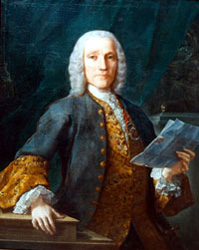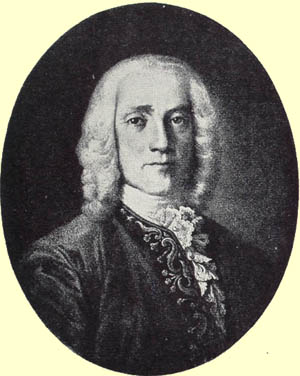

Italian composer. He was the sixth of ten children of Alessandro Scarlatti and Antonia Anzalone. Nothing is known of his musical training; while he profited from the study of compositions by Gasparini, Greco, Pasquini, and the elder Scarlatti, it is not certain that any of them were his actual teachers. His name does not appear on any conservatory rosters. On September 13, 1701, he was appointed organista e compositore di musicaof the Naples royal chapel, of which his father was maestro. What the younger Scarlatti's official duties were remains obscure, and none of his compositions from the period of his employment at the Neapolitan court appear to be extant. In 1702 father and son left for Florence on a four-month leave of absence. There Domenico may have met the keyboard instrument maker Bartolomeo Cristofori, who was then experimenting with the hammer action of his gravicembalo col piano e forte.
Alessandro soon left for Rome, while Domenico returned to Naples and assumed his father's duties there for the 1703-4 season. Two operas, L'Ottavia ristituita al tronoand Il Giustino(both 1703), probably marked the 18-year-old's debut as an opera composer. But any hopes Alessandro may have had that his son would succeed him as maestro di cappellain Naples were not realized; Domenico soon resigned his post and joined his father in Rome. In May 1705, in an effort to secure a post for his son, Alessandro sent Domenico to Venice through Florence in the company of the famous castrato Nicolo Grimaldi, known as 'Nicolino' or 'Nicolini.' Nothing is known of Domenico's stay in Venice except that there he probably became acquainted with Gasparini, Vivaldi, and Handel; by January 1708 he had returned to Rome. Scarlatti's alleged second encounter with Handel presumably took place in 1708 or early 1709. This was the famous contest in virtuosity, at which Handel is said to have prevailed at the organ while Scarlatti held his own on the harpsichord; but the event is reported only in Mainwaring's biography of Handel, written many years later. At the weekly concerts established by Cardinal Pietro Ottoboni, Scarlatti met virtuosos and composers including Corelli and the young Thomas Roseingrave, who was to play an active role in disseminating Scarlatti's music in England and Ireland. In 1709 Scarlatti entered the service of Queen Maria Casimira. of Poland, living in self-imposed exile in Rome. In the libretto of his opera L'Orlando(1711) he is named as the queen's maestro di cappella.By the time she left for France in 1714, she had received from Scarlatti at least one cantata, one oratorio, and seven operas.

On November 1713 Scarlatti was named assistant maestro di cappellaof the Cappella Giulia at St. Peter's; he succeeded to the senior post at the death of Tommaso Baj in December 1714. Earlier that year Scarlatti had been appointed maestro di cappellato the Marques de Fontes, Portuguese ambassador to the Vatican. Despite his growing success, Domenico had been unable to free himself from his father's control. Finally, on January 28, 1717 he was granted legal independence from Alessandro.
In August 1719 Scarlatti resigned his positions at Rome and went to Palermo, where a 'Dominicus Scarlatti' was admitted to the Unione di Santa Cecilia on 16 April 1720; he remained there until at least December 1722. By about 1723 he was in Lisbon, serving as mestre de capela.The following year he traveled to Rome, where he met Quantz and possibly the great castrato Carlo Broschi, better known as Farinelli. He returned there in 1728 to marry 16-year-old Maria Catarina Gentili.
Only with his definitive departure from Italy, and after his father's death in 1725, does Domenico Scarlatti appear to have developed the style that has rendered him one of the greatest keyboard composers of all time. For nearly ten years he was attached to the Portuguese court as chapel-master, and also served as music-master to the young Princess Maria Barbara and her younger brother, Don Antonio. Upon the former's marriage in 1729 to the heir to the Spanish throne, Fernando VI, he moved to Spain, spending the last 28 years of his life at the Spanish court. Most of the five hundred and fifty-odd surviving harpsichord sonatas appear to have been written for this musically unusually gifted princess.
In Madrid, Scarlatti was for a time alone in the musical spotlight; when Farinelli arrived in 1737 the composer's position must have changed to some degree. On April 21, 1738 knighthood was conferred on Scarlatti by his former patron, King John V of Portugal. His earliest dated collection of sonatas was published in 1738 under the title Essercizi per Gravicembalo,and dedicated to King John. From this time on Scarlatti hardly composed any more vocal music, but confined himself to the writing of several hundred harpsichord sonatas. In these he conferred on the binary form a variety and expressive range that have never been surpassed by any other composer.The following year his wife died; sometime before 1742 he married Anastasia Maxarti Ximenes, the mother of his last four children.
When Scarlatti died in Madrid on July 23, 1757, he left behind him a few manuscript collections of sonatas that remained almost entirely unknown to the world at large until their partial publication by Czerny in 1839 and their virtually complete publication by Longo in 1906. Throughout the 18th century he was known largely only for his earliest sonatas, many of which were published in England. The general recognition that he first gained in England as a result of these publications was founded on the relatively limited scope of these earlier works.
From 1752 to 1757 thirteen volumes of Scarlatti sonatas were copied out for the use of Queen Maria Barbara. They were carefully written in a rather large format like that of the Essercizi,widely spaced and decorated with colored inks. To this series were added two preliminary volumes that had been copied out in 1742 and in 1749, likewise decorated with colored inks. The volume of 1749 is even further illuminated with gold for the titles, tempo marks, and hand indications. All fifteen volumes were bound in red morocco with the combined arms of Spain and Portugal tooled in gold on the cover. I n 1835 the Queen's set of Scarlatti sonatas was acquired by the Biblioteca Marciana in Venice. The fifteen manuscript volumes (the 'Venice manuscripts') contain 496 sonatas. (The volumes that have since been numbered XIV and XV are actually the earliest, from 1742 and 1749 respectively, that preceded the thirteen volumes of the series proper.)
An additional fifteen volumes, largely duplicating the Queen's series, were copied out from 1752 to 1757, in part at least by the same copyist. They lack the colored decorations of the Queen's set, and are bound up in plain leather. Now they are the property of the Sezione Musicale of the Biblioteca Palatina, housed in the Conservatorio Arrigo Boïto at Parma, (hence called 'Parma manuscripts'). This set of manuscripts contains 463 sonatas. In a few cases their dates are earlier than those of the parallel Venice manuscripts. Among them are a few not contained in the Venice manuscripts, most notably the twelve sonatas that are apparently Scarlatti's last. Together with the Essercizi,these two sets of manuscripts by the Queen's copyists form the principal sources for all but a few of the 555 Scarlatti sonatas. Except for a few earlier pieces, the first thirteen volumes of the 'Venice manuscripts' appear to have been collected in approximately chronological order, and there is every indication that most of them were composed at this time.
In these two collections Scarlatti first shows the full range of his genius and at last demonstrates his full maturity. He was 67 years old. Yet a gradual change is still perceptible, a still further process of maturing that continues through the very last sonatas. The 'ingenious jesting with art' and the 'happy freaks' of the Esserciziand the sonatas of the intervening period have given way to a style of writing that renders the harpsichord sonata a full vehicle for the entire expression of Scarlatti's personality and for the distillation of his entire life's experience and fund of sentiment.
This music ranges from the courtly to the savage, from a wellnigh saccharine urbanity to an acrid violence. Its gaiety is all the more intense for an undertone of tragedy. Its moments of meditative melancholy are at times overwhelmed by a surge of extrovert operatic passion. Most particularly he has expressed that part of his life which was lived in Spain. There is hardly an aspect of Spanish life, of Spanish popular music and dance, that has not found itself a place in the microcosm that Scarlatti created with his sonatas. No Spanish composer, not even Manuel de Falla, has expressed the essence of his native land as completely as did the foreigner Scarlatti. He has captured the click of castanets, the strumming of guitars the thud of muffled drums, the harsh bitter wail of gypsy lament, the overwhelming gaiety of the village band, and above all the wiry tension of the Spanish dance.
All of this does not find expression merely in loosely knit impressionistic program music, but is assimilated and distilled with all the rigor that Scarlatti had learned from his sixteenth-century ecclesiastical masters, and is given forth again in a pure musical language that extends far beyond the domain of mere harpsichord virtuosity. In late Scarlatti there is as little of the hap hazard as there is of the pedantic. All is assimilated into an unfailing sense of the larger context. In those last five years as he wrote sonata after sonata Scarlatti was reliving his entire life, living it more intensely than ever before, bringing it to fruition.
Of the 555 surviving Scarlatti sonatas nearly 400, principally late works, are brought together in pairs. One may be in minor and the other in major, but both members of a pair always have the same tonic. The relationship between the sonatas of a pair is either one of contrast or of complement. The sonatas that bear a complementary relationship to each other may share a certain overall unity of style or of instrumental character or they may be composed in the same harmonic color. In the contrasting pairs, a slow movement may be followed by a fast; a simple movement, generally slow, may serve as an introduction to a more elaborate; or an elaborate and concentrated movement may be followed by a simpler and lighter movement, for example a Minuet, which serves as a kind of Nachtanz.
The movements themselves are characterized by unconventional features, which include eccentric gestures, irregular phrases or groups of phrases, extensive use of the acciaccatura, and unusual modulations. Scarlatti also explored virtuoso technique in these sonatas, employing devices such as frequent crossing of the hands, runs in thirds and sixths, leaps wider than an octave, rapid arpeggio figurations, and rapid repeated notes.